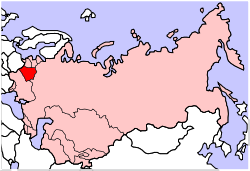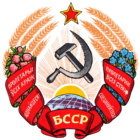Byelorussian Soviet Socialist Republic
| Беларуская Савецкая Сацыялістычная Рэспубліка (Belarusian) Белорусская Советская Социалистическая Республика (Russian) Byelorussian Soviet Socialist Republic |
|||||
|
|||||
|
|||||
 |
|||||
| Capital | Smolensk, Minsk | ||||
| Official language | Belarusian, Russian, Polish, Yiddish (the last two only official before WWII) | ||||
| Established In the Soviet Union: - Since - Until |
1 January 1919 30 December 1922 25 December 1991 |
||||
| Area - Total - Water (%) |
Ranked 6th in the USSR 207,600 km² negligible |
||||
| Population - Total - Density |
Ranked 5th in the USSR 10,151,806 (1989) 48.9/km² |
||||
| Time zone | UTC + 3 | ||||
| Anthem | Anthem of Byelorussian SSR | ||||
| Medals | |||||
| History of Belarus | |
|---|---|
.svg.png)  This article is part of a series |
|
| Early East Slavs | |
| Principality of Polatsk | |
| Kievan Rus' | |
| Kingdom of Galicia–Volhynia | |
| Golden Horde | |
| Grand Duchy of Lithuania | |
| Polish–Lithuanian Commonwealth | |
| Russian Empire | |
| Belarusian People’s Republic | |
| Socialist Soviet Republic of Byelorussia | |
| West Belarus | |
| Byelorussian Soviet Socialist Republic | |
| Modern Belarus | |
|
Belarus Portal |
The Byelorussian Soviet Socialist Republic (abbreviated as Byelorussian SSR or BSSR) (Belarusian: Беларуская Савецкая Сацыялістычная Рэспубліка [БССР] Belaruskaya Savetskaya Satsyyalistychnaya Respublika [BSSR]; Russian: Белору́сская Сове́тская Социалисти́ческая Респу́блика [БССР] Belorusskaya Sovetskaya Sotsalisticheskaya Respublika [BSSR]) was one of fifteen constituent republics of the Soviet Union. It was one of the four original founding members of the Soviet Union in 1922, together with the Ukrainian SSR, the Transcaucasian SFSR and the Russian SFSR. The Soviet Republic, along with the Ukrainian SSR and the Soviet Union, were founder members of the United Nations Organization in 1945.
The Soviet republic, Socialist Soviet Republic of Byelorussia, in the lands of Belarus was declared on 1 January 1919, but it took a few years to define its status. Byelorussia was also one of several Soviet Republics occupied by Nazi Germany during World War II. The end of the Soviet Republic occurred in 1991 and the country was later renamed into the current Republic of Belarus.
Contents |
History
Being part of the Russian Empire before World War I, Belarus declared independence on 25 March 1918, forming the Belarus National Republic. The Republic was, however, short-lived, and was overthrown soon after the German withdrawal. On 1 January 1919 the Soviet Socialist Republic of Belarus (SSRB) was created. Soon it was disbanded, its territory merged into the RSFSR and the new Lithuanian-Belorussian Soviet Socialist Republic. The latter one was also short-lived, overridden by the 1919 Polish invasion. After Polish-Soviet War ended in 1921, Byelorussian lands were split between Poland, Russia, and the recreated SSRB[1], which became a founding member of the Soviet Union in 1922 and became known as BSSR.
Polish Autonomous District Dzierzynszczyzna was created within BSSR in 1932 and disbanded in 1935.
In September 1939, the Soviet Union annexed the Polish-held West Belarus during the 1939 invasion of Poland and incorporated it into the BSSR. Part of it, including the city of Vilno, was later transferred to the Lithuanian SSR. During the World War II, the territory was governed by the Belarusian Central Rada.
After World War II, the Byelorussian SSR was given a seat in the United Nations General Assembly together with the Soviet Union and Ukrainian SSR, becoming one of the founding members of the UN. This was part of a deal with the United States to ensure a degree of balance in the General Assembly, which, the USSR opined, was unbalanced in favor of the Western Bloc. A Byelorussian, G.G. Tchernouchtchenko, served as President of the United Nations Security Council from January-February 1975.
Following the August Coup, the Supreme Soviet of Belarus declared independence from the Soviet Union on 25 August 1991. The republic was renamed the Republic of Belarus on 19 September 1991. On 8 December 1991 it was a signatory, along with Russia and Ukraine, of the Belavezha Accords, which replaced the Soviet Union with the Commonwealth of Independent States. Belarus receieved independence on December 25, 1991. A day later the Soviet Union ceased to exist.
Demographics
According to the 1959 Soviet Census, the population of the republic were made up as follows:
Nationalities (1959):
- Belarusians - 81%
- Poles - 16%
- Ukrainians - about 1%
- Russians - <1%
Other ethnic/religious groups (1959):
- Jews - about 1%
The largest cities were:
References
- ↑ In Soviet historiography the term "SSRB" was suppressed, but there is documentary evidence of the usage of the term SSRB rather than BSSR, see, e.g., A 1992 cancellation of a 1921 SSRB laws
External links
- Byelorussia : speeding towards abundance by Tikhon Kiselev
|
||||||||||||||
|
||||||||||||||||||||||||||||||||



